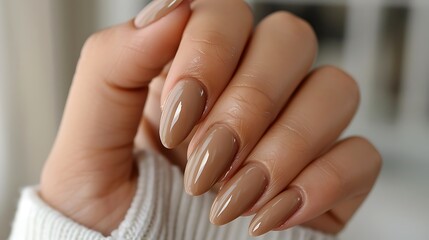
Table of Contents
ToggleIntroduction
When it comes to enhancing the appearance of your nails, choosing between gel and acrylic options can be a daunting task. Understanding the differences between these two popular nail enhancement techniques is crucial in making an informed decision. In this comprehensive guide, we will delve deep into the difference between gel and acrylic nails, exploring their unique characteristics, benefits, drawbacks, and maintenance requirements. Whether you are looking for a natural look or seeking durability, this detailed comparison will help you make the best choice for your nail needs.
What Are Gel Nails?
Gel nails are a popular choice for those who want a more natural look and feel. This method involves applying a gel-like substance to the natural nail, which is then cured under a UV or LED lamp. The curing process hardens the gel, creating a durable and glossy finish. The application typically includes a base coat, one or more color coats, and a top coat, each requiring separate curing times. The result is a flexible, shiny nail enhancement that closely mimics the appearance of natural nails. However, the flexibility of gel nails, while offering a more natural feel, can sometimes lead to issues with chipping if not properly maintained.
What Are Acrylic Nails?
Acrylic nails, on the other hand, are known for their strength and durability. The process involves mixing a liquid monomer with a powder polymer to create a hard substance that is applied to the natural nail. This mixture hardens naturally over time, forming a solid and resilient nail extension. Acrylic nails are applied in layers, and they can be sculpted into various shapes and lengths according to personal preference. The resulting nails are typically thicker and more rigid than gel nails, offering excellent durability and resistance to breakage. However, the rigidity of acrylic nails can sometimes affect their natural appearance and feel.
![]()
Application Process: Gel vs. Acrylic
The application process for gel and acrylic nails involves distinct steps, each contributing to the overall outcome. For gel nails, the procedure begins with the application of a base coat, followed by one or more layers of colored gel, and finally, a top coat. Each layer must be cured under a UV or LED lamp to ensure proper hardening. This process results in a glossy, natural-looking finish. Conversely, acrylic nails are created by mixing a liquid monomer with a powder polymer, which is then applied to the natural nail. This mixture is sculpted and left to harden, forming a solid and durable extension. The application of acrylic nails can be more time-consuming and requires precise shaping and filing.
Durability and Strength: Gel vs. Acrylic
When comparing the difference between gel and acrylic nails, durability and strength are key factors to consider. Acrylic nails are renowned for their robustness and resistance to breakage. They are an ideal choice for individuals who require extra strength due to their lifestyle or nail habits. Acrylics can withstand significant pressure and impact, making them suitable for those with active or demanding routines. Gel nails, while strong, are generally less durable than acrylics. They offer flexibility and a natural appearance but may be more prone to chipping or peeling over time. For those seeking a balance between strength and natural aesthetics, gel nails may be a more suitable option.
Appearance and Finish: Gel vs. Acrylic
The appearance and finish of gel and acrylic nails can significantly impact your overall satisfaction with the nail enhancement. Gel nails are known for their glossy, high-shine finish, which closely resembles the natural look of healthy nails. The gel’s flexibility allows for a more natural feel and appearance, making them a popular choice for those seeking a subtle enhancement. In contrast, acrylic nails can be more opaque and less shiny compared to gel nails. While they offer a wide range of customization options in terms of shapes and lengths, they may not always provide the same level of natural appearance as gel nails. Choosing between gel and acrylic depends on your preference for natural aesthetics versus durability and customization.
Removal Process: Gel vs. Acrylic
The removal process for gel and acrylic nails is another crucial aspect of understanding the difference between gel and acrylic nails. Gel nails are typically removed by soaking them in acetone, which softens the gel and allows it to be gently scraped off. This process can be time-consuming and may require several applications of acetone to fully remove the gel. It is important to avoid peeling off gel nails, as this can damage the natural nail underneath. Acrylic nails, on the other hand, are also removed by soaking in acetone. However, the removal process can be more intensive due to the hardness of the acrylic material. Acrylic nails may require additional filing and soaking to ensure complete removal, which can be more damaging to the natural nails if not done carefully.

Maintenance and Upkeep: Gel vs. Acrylic
Maintaining and upkeeping gel and acrylic nails involves different considerations. Gel nails require regular touch-ups as the natural nails grow. The gel can be prone to chipping or lifting, especially at the tips, necessitating frequent maintenance appointments. It is also important to follow proper aftercare to avoid issues such as lifting or discoloration. Acrylic nails, while durable, also require regular fills to manage the gap between the acrylic and natural nail as they grow. Proper maintenance involves keeping the nails clean, avoiding excessive moisture, and addressing any signs of lifting or damage promptly. Both types of nails benefit from occasional breaks to allow the natural nails to recover and stay healthy.
Health Considerations: Gel vs. Acrylic
Understanding the health implications of gel and acrylic nails is essential when evaluating the difference between gel and acrylic nails. Gel nails, while generally less damaging, can still impact the health of the natural nails if not applied or removed correctly. The UV or LED lamps used for curing gel nails can expose the skin to potentially harmful rays, although the risk is relatively low. Acrylic nails, due to their application and removal processes, can be more damaging to the natural nails. The filing and soaking involved in acrylic nail maintenance can weaken the natural nails and cause damage if not done properly. It is important to follow best practices for nail health and seek professional help if issues arise.
Cost Comparison: Gel vs. Acrylic
Cost is another important factor when comparing gel and acrylic nails. Generally, gel nails tend to be more expensive than acrylics due to the specialized products and equipment required for their application and curing. The cost of gel nails can vary based on the salon and the complexity of the design. Acrylic nails, while often more affordable initially, may require more frequent maintenance and fills, which can add to the overall cost over time. Both types of nails have their associated costs, and the choice may depend on your budget and the value you place on the durability and appearance of the nail enhancement.
Longevity and Wear: Gel vs. Acrylic
The longevity and wear of gel and acrylic nails are crucial considerations when choosing between the two options. Gel nails typically last around two to three weeks before requiring a touch-up or fill. They offer a relatively long-lasting enhancement with proper care but may show signs of wear sooner than acrylics. Acrylic nails, due to their strength and durability, can last up to four weeks or more before needing maintenance. They are less likely to chip or break compared to gel nails, making them a good option for those seeking a longer-lasting solution. The wear and longevity of both types of nails depend on various factors, including lifestyle, nail care habits, and individual nail health.

Customization Options: Gel vs. Acrylic
Customization is a significant factor for many when choosing between gel and acrylic nails. Acrylic nails offer extensive customization options in terms of shapes, lengths, and designs. The material can be easily sculpted and shaped to create a wide variety of looks, making it a popular choice for those who enjoy experimenting with their nail aesthetics. Gel nails, while offering some level of customization, are generally less flexible in terms of shaping compared to acrylics. However, they provide a glossy finish and natural appearance that can be enhanced with various colors and designs. The choice between gel and acrylic may ultimately depend on your preference for customization and the specific look you wish to achieve.
Convenience and Ease of Application: Gel vs. Acrylic
Convenience and ease of application are important factors when considering the difference between gel and acrylic nails. Gel nails are known for their relatively quick application process, with each layer curing under a UV or LED lamp. The gel’s flexibility and natural appearance can be appealing for those seeking a straightforward enhancement. Acrylic nails, while offering excellent durability, involve a more intricate application process that includes mixing and sculpting the acrylic material. This process can be more time-consuming and requires precise skill to achieve the desired results. The convenience of each method may depend on your individual preferences and the level of complexity you are comfortable with.
Risks and Potential Issues: Gel vs. Acrylic
Understanding the risks and potential issues associated with gel and acrylic nails is essential for making an informed decision. Gel nails, while generally safe, can pose risks if not applied or maintained correctly. Issues such as lifting, chipping, and discoloration can occur if the gel is not properly cured or if the nails are exposed to excessive moisture. Acrylic nails, due to their hardness and the application process, can also present risks. Potential problems include lifting, fungal infections, and damage to the natural nails if the acrylic is not applied or removed properly. It is important to be aware of these risks and take appropriate measures to ensure the health and longevity of your nail enhancements.
Environmental Impact: Gel vs. Acrylic
The environmental impact of gel and acrylic nails is another aspect to consider when evaluating their differences. Gel nails generally have a lower environmental impact compared to acrylics. The use of UV or LED lamps for curing gel nails produces less waste and has a lower environmental footprint. In contrast, the chemicals used in acrylic nail applications and removals can contribute to environmental pollution if not properly managed. Additionally, the disposal of acrylic products and materials can have a more significant environmental impact. Choosing eco-friendly options and proper disposal practices can help mitigate the environmental effects of both types of nail enhancements.

Popularity and Trends: Gel vs. Acrylic
The popularity and trends surrounding gel and acrylic nails have evolved over time, reflecting changing preferences and innovations in nail care. Gel nails have gained popularity in recent years due to their natural appearance, flexibility, and glossy finish. They are often favored for their ease of application and the ability to achieve a sleek, shiny look. Acrylic nails, however, continue to be popular for their strength, durability, and extensive customization options. Trends in nail enhancements often reflect a balance between natural aesthetics and durability, with both gel and acrylic options offering unique benefits to meet diverse preferences.
Choosing the Right Option for You
Ultimately, choosing between gel and acrylic nails depends on your individual needs, preferences, and lifestyle. If you prioritize a natural look and flexibility, gel nails may be the ideal choice for you. They offer a glossy finish and a more natural appearance, making them suitable for those who prefer a subtle enhancement. On the other hand, if you require extra strength and durability, acrylic nails may be more appropriate. They provide excellent resistance to breakage and can be customized to achieve various shapes and lengths. Consider your priorities, budget, and nail health when making your decision, and consult with a professional nail technician for personalized advice.
Conclusion
Understanding the difference between gel and acrylic nails is essential for making an informed choice about your nail enhancements. Gel nails offer a natural look and flexible feel, while acrylic nails provide durability and customization options. Both methods require regular maintenance and proper care to ensure the health and longevity of your nails. By weighing the characteristics, benefits, and drawbacks of each option, you can select the best choice for your needs and preferences. Whether you opt for the glossy finish of gel nails or the robust strength of acrylics, both types of nail enhancements offer unique advantages to enhance your appearance and boost your confidence.





